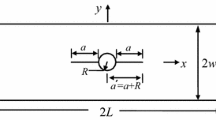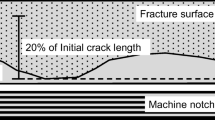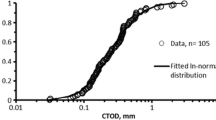Abstract
The double cleavage drilled compression (DCDC) geometry is useful for creating large cracks in a material in a controlled manner. Several models for estimating fracture toughness from DCDC measurements have been proposed, but each is suitable for a subset of geometries and material properties. In this work, a series of finite element fracture simulations are performed over a range of sample widths, hole sizes, heights, Young’s moduli, Poisson’s ratios, critical stress intensity factors, and boundary conditions. Analyzing the simulation results, fracture toughness is found to be a simple function of sample width, hole size, and an extrapolated stress at zero crack length obtained from a linear fit of the data. Experimental results in the literature are found to agree with this simple relationship.



Similar content being viewed by others
References
Chen X, Dam MA, Ono K, Mal A, Shen H, Nutt SR, Sheran K, Wudl F (2002) A thermally re-mendable cross-linked polymeric material. Science 295:1698–1702
Hamilton AR, Sottos NR, White SR (2010) Self-healing of internal damage in synthetic vascular materials. Adv Mater 22:5159–5163
He MY, Turner MR, Evans AG (1995) Analysis of the double cleavage drilled compression sample for interface fracture energy measurements over a range of mode mixities. Acta Metall et Mater 43:3453–3458
Horii H, Nemat-Nasser S (1985) Compression-induced microcrack growth in brittle solids: axial splitting and shear failure. J Geophys Res Sol Earth 90(B4):3105–3125
Janssen C (1974) Specimen for fracture mechanics studies on glass. 10th International congress on glass: Kyoto, Japan. Ceramic Society of Japan
Michalske TA, Smith WL, Chen EP (1993) Stress intensity calibration for the double cleavage drilled compression specimen. Eng Fract Mech 45:637–642
Nielsen C, Amirkhizi AV, Nemat-Nasser S (2012) The effect of geometry on fracture strength measurements using DCDC samples. Eng Fract Mech 91:1–13
Plaisted TA, Amirkhizi AV, Nemat-Nasser S (2006) Compre- ssion-induced axial crack propagation in DCDC polymer samples: experiments and modeling. Int J Fract 141:447–457
Plaisted TA, Nemat-Nasser S (2007) Quantitative evaluation of fracture, healing and re-healing of a reversibly cross-linked polymer. Acta Mater 55:5684–5696
Weiderhorn SM, Johnson H, Diness AM, Heuer AH (1974) Fracture of glass in vacuum. J Am Ceram Soc 57:336–341
Acknowledgments
This work was funded by Air Force Office of Scientific Research Grant FA9550-08-1-0314 to UC San Diego.
Author information
Authors and Affiliations
Corresponding author
Rights and permissions
About this article
Cite this article
Nielsen, C., Amirkhizi, A.V. & Nemat-Nasser, S. An empirical model for estimating fracture toughness using the DCDC geometry. Int J Fract 188, 113–118 (2014). https://doi.org/10.1007/s10704-014-9945-5
Received:
Accepted:
Published:
Issue Date:
DOI: https://doi.org/10.1007/s10704-014-9945-5




